
The Final Solution or the Final Solution to the Jewish Question was a Nazi plan for the genocide of individuals they defined as Jews during World War II. The "Final Solution to the Jewish question" was the official code name for the murder of all Jews within reach, which was not restricted to the European continent. This policy of deliberate and systematic genocide starting across German-occupied Europe was formulated in procedural and geopolitical terms by Nazi leadership in January 1942 at the Wannsee Conference held near Berlin, and culminated in the Holocaust, which saw the murder of 90% of Polish Jews, and two-thirds of the Jewish population of Europe.

Nazi Germany used six extermination camps, also called death camps, or killing centers, in Central Europe during World War II to systematically murder over 2.7 million people – mostly Jews – in the Holocaust. The victims of death camps were primarily murdered by gassing, either in permanent installations constructed for this specific purpose, or by means of gas vans. The six extermination camps were Chełmno, Belzec, Sobibor, Treblinka, Majdanek and Auschwitz-Birkenau. Extermination through labour was also used at the Auschwitz and Majdanek death camps. Millions were also murdered in concentration camps, in the Aktion T4, or directly on site.

The Schutzstaffel was a major paramilitary organisation under Adolf Hitler and the Nazi Party in Nazi Germany, and later throughout German-occupied Europe during World War II.
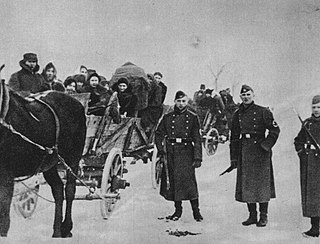
Belzec was a Nazi German extermination camp in occupied Poland. It was built by the SS for the purpose of implementing the secretive Operation Reinhard, the plan to murder all Polish Jews, a major part of the "Final Solution" which in total entailed the murder of about six million Jews in the Holocaust. The camp operated from 17 March 1942 to the end of June 1943. It was situated about 500 m (1,600 ft) south of the local railroad station of Bełżec, in the new Lublin District of the General Government territory of German-occupied Poland. The burning of exhumed corpses on five open-air grids and bone crushing continued until March 1943.
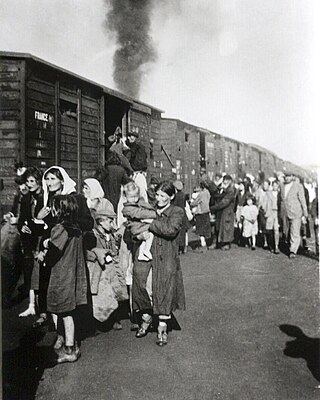
Operation Reinhard or Operation Reinhardt was the codename of the secret German plan in World War II to exterminate Polish Jews in the General Government district of German-occupied Poland. This deadliest phase of the Holocaust was marked by the introduction of extermination camps. The operation proceeded from March 1942 to November 1943; around 1.47 million Jews were murdered in just 100 days from July to October 1942, a rate approximately 83% higher than the commonly suggested figure for the kill rate in the Rwandan genocide.
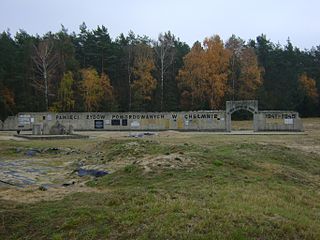
Chełmno or Kulmhof was the first of Nazi Germany's extermination camps and was situated 50 km (31 mi) north of Łódź, near the village of Chełmno nad Nerem. Following the invasion of Poland in 1939, Germany annexed the area into the new territory of Reichsgau Wartheland. The camp, which was specifically intended for no other purpose than mass murder, operated from December 8, 1941, to April 11, 1943, parallel to Operation Reinhard during the deadliest phase of the Holocaust, and again from June 23, 1944, to January 18, 1945, during the Soviet counter-offensive. In 1943, modifications were made to the camp's killing methods as the reception building had already been dismantled.

The Holocaust—the murder of about six million Jews by Nazi Germany from 1941 to 1945—is the best-documented genocide in history. Although there is no single document which lists all Jewish victims of Nazi persecution, there is conclusive evidence that about six million were murdered. There is also conclusive evidence that Jews were gassed at Auschwitz-Birkenau, the Operation Reinhard extermination camps, and in gas vans, and that there was a systematic plan by the Nazi leadership to murder them.
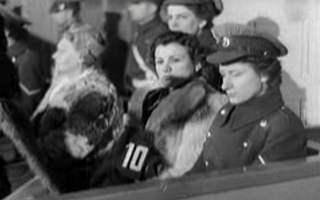
The Hamburg Ravensbrück trials were seven trials for war crimes during the Holocaust against camp officials from the Ravensbrück concentration camp that the British authorities held in their occupation zone in Germany in Hamburg after the end of World War II. These trials were heard before a military tribunal; the three to five judges at these trials were British officers, assisted by a lawyer. The defendants included concentration camp personnel of all levels: SS officers, camp doctors, male guards, female guards (Aufseherinnen), and a few former prisoner-functionaries who had tortured or mistreated other inmates. In total, 38 defendants were tried in these seven trials; 21 of the defendants were women. One of the defendants died during the trial. Twenty of the defendants received death sentences. One defendant was reprieved while two others committed suicide before they could be executed. The remaining 17 death sentences relating to these trials were carried out on the gallows at Hamelin Prison by British hangman Albert Pierrepoint.

The Auschwitz trial began on November 24, 1947, in Kraków, when Poland's Supreme National Tribunal tried forty former staff of the Auschwitz concentration camps. The trials ended on December 22, 1947.

The subsequent Nuremberg trials were twelve military tribunals for war crimes committed by the leaders of Nazi Germany (1933–1945). The Nuremberg Military Tribunals occurred after the Nuremberg trials, held by the International Military Tribunal, which concluded in October 1946. The subsequent Nuremberg trials were held by U.S. military courts and dealt with the cases of crimes against humanity committed by the business community of Nazi Germany, specifically the crimes of using slave labor and plundering occupied countries, and the war-crime cases of Wehrmacht officers who committed atrocities against Allied prisoners of war, partisans, and guerrillas.

The Dachau trials, also known as the Dachau Military Tribunal, handled the prosecution of almost every war criminal captured in the U.S. military zones in Allied-occupied Germany and in Allied-occupied Austria, and the prosecutions of military personnel and civilian persons who committed war crimes against the American military and American citizens. The war-crime trials were held within the compound of the former Dachau concentration camp by military tribunals authorized by the Judge Advocate General of the U.S. Third Army.

Sonderaktion1005, also called Aktion1005 or Enterdungsaktion, was a top-secret Nazi operation conducted from June 1942 to late 1944. The goal of the project was to hide or destroy any evidence of the mass murder that had taken place under Operation Reinhard, the attempted extermination of all Jews in the General Government occupied zone of Poland. Groups of Sonderkommando prisoners, officially called Leichenkommandos, were forced to exhume mass graves and burn the bodies; inmates were often put in chains to prevent them from escaping.

Holocaust trains were railway transports run by the Deutsche Reichsbahn national railway system under the control of Nazi Germany and its allies, for the purpose of forcible deportation of the Jews, as well as other victims of the Holocaust, to the Nazi concentration, forced labour, and extermination camps.

The two Treblinka trials concerning the Treblinka extermination camp personnel began in 1964. Held at Düsseldorf in West Germany, they were the two judicial trials in a series of similar war crime trials held during the early 1960s, such as the Jerusalem Adolf Eichmann trial (1961) and the Frankfurt Auschwitz Trials (1963–65), as a result of which the general public came to realize the extent of the crimes that some two decades earlier had been perpetrated in occupied Poland by German bureaucrats and their willing executioners. In the subsequent years, separate trials dealt with personnel of the Bełżec (1963–65), Sobibor (1966), and Majdanek (1975–81) extermination camps.
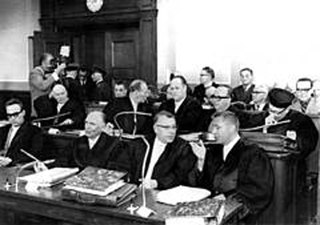
The Sobibor trial was a 1965–66 judicial trial in the West German prosecution of SS officers who had worked at Sobibor extermination camp; it was held in Hagen. It was one of a series of similar war crime trials held during the early and mid-1960s, such as the 1961 trial of Adolf Eichmann by Israel in Jerusalem, and the Frankfurt Auschwitz Trials of 1963–65, also held in West Germany. These trials heightened general public and international understanding of the extent of the crimes that had been perpetrated in occupied Poland some twenty years earlier by Nazi bureaucrats and persons acting as their executioners.

The Belzec trial in the mid-1960s was a war crimes trial of eight former SS members of Bełżec extermination camp. The trial was held at the 1st Munich District Court and should be seen in the context of the Sobibor trial, which followed the Belzec trial, because five of the defendants were accused in both trials. In addition, the Belzec and Sobibor trials, along with the Treblinka trials, form a body of evidence of the crimes of mass extermination as part of the so-called Action Reinhardt programme - the killing of over two million Jews and 50,000 Roma and Sinti. These trials are directly related to the mass murder of 100,000 people in the official Nazi Euthanasia programme known after the war as Action T4, as many of the security guards worked in the euthanasia centres before transferring to the extermination camps. The first Euthanasia trials were carried out shortly after the war.
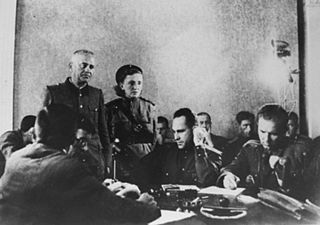
The Majdanek trials were a series of consecutive war-crime trials held in Poland and in Germany during and after World War II, constituting the overall longest Nazi war crimes trial in history spanning over 30 years. The first judicial trial of Majdanek extermination camp officials took place from November 27, 1944, to December 2, 1944, in Lublin, Poland. The last one, held at the District Court of Düsseldorf began on November 26, 1975, and concluded on June 30, 1981. It was West Germany's longest and most expensive trial, lasting 474 sessions.
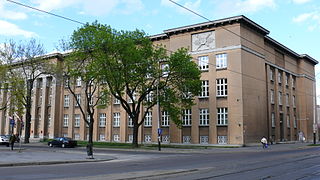
The Chełmno trials were a series of consecutive war-crime trials of the Chełmno extermination camp personnel, held in Poland and in Germany following World War II. The cases were decided almost twenty years apart. The first judicial trial of the former SS men – members of the SS-Sonderkommando Kulmhof – took place in 1945 at the District Court in Łódź, Poland. The subsequent four trials, held in Bonn, Germany, began in 1962 and concluded three years later, in 1965 in Cologne.

Der Ort des Terrors. Geschichte der nationalsozialistischen Konzentrationslager is a nine-volume German encyclopedia series of Nazi Germany's camp system, published between 2005 and 2009 by Wolfgang Benz and Barbara Distel for C. H. Beck. It was edited by Angelika Königseder of the Zentrum für Antisemitismusforschung. The first volume deals with central issues concerning the Nazi camp system, volumes 2 to 7 contain articles on the main concentration camps and their subcamps in chronological order. Volume 8 deals with concentration and extermination camps in German-occupied Eastern Europe. Volume 9 also lists other types of camps in the Nazi forced labor camp system.


















